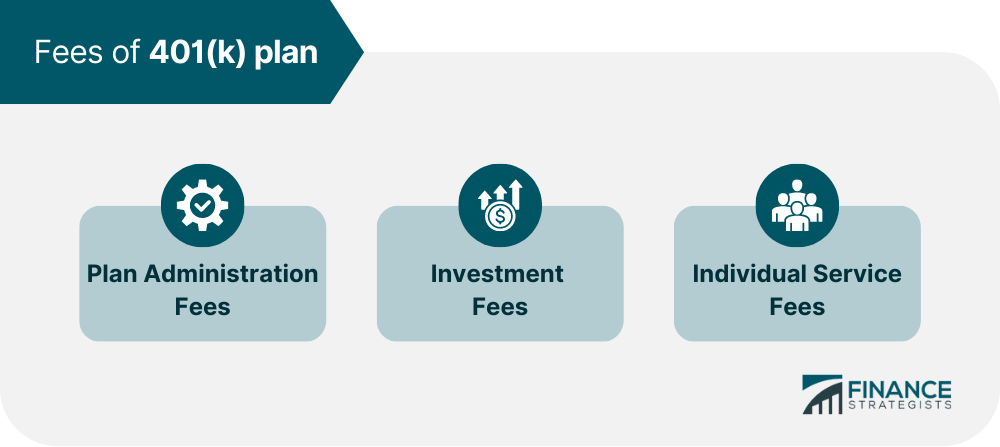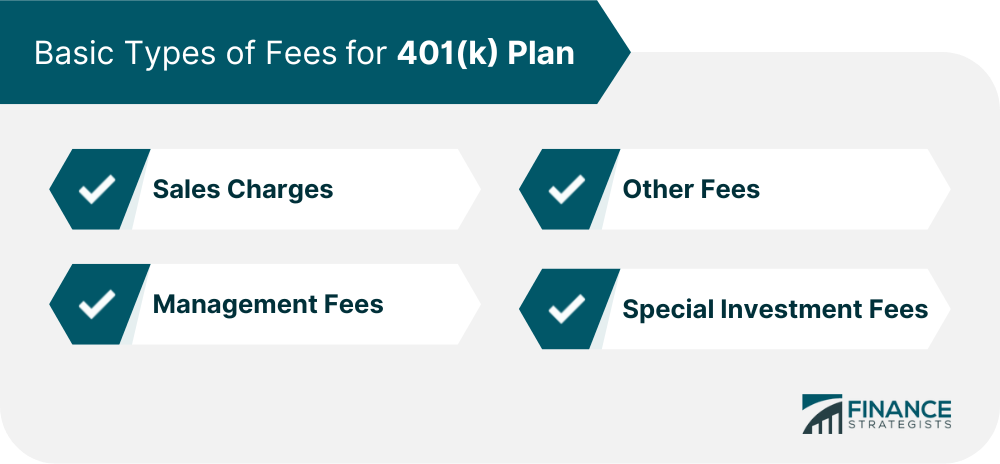While 401(k) plans offer key benefits to both employers and employees, one factor that is often overlooked-at least by many employees-is the various costs and fees that the plan charges to both the plan sponsor (employer) and its participants. It is important to know how much you are paying in fees to your 401(k) plan provider whether you are an employer or employee. These fees can have a material impact on both the employer's bottom line and a plan participant's rate of return over time. A breakdown of the various fees that a 401(k) plan usually charges includes: Plan administration fees: The day-to-day operation of a 401(k) plan involves expenses for basic and necessary administrative services, such as plan record-keeping, accounting, legal, and trustee services. A 401(k) plan also may offer a host of additional services, such as telephone voice-response systems, access to customer service representatives, educational seminars, retirement planning software, investment advice, electronic access to plan information, daily valuation, and online transactions. In some instances, administrative service costs are covered by investment fees that are deducted directly from investment returns. Otherwise, if administrative costs are separately charged, they will be borne either by your employer or charged directly against the assets of the plan. When paid directly by the plan, administrative fees are either allocated among participants' individual accounts in proportion to each account balance (i.e., participants with larger account balances pay more of the allocated expenses) or passed through as a flat fee against each participant's account. Either way, generally the more services provided, the higher the fees. Investment fees: By far the largest component of 401(k) plan fees and expenses is associated with managing plan investments. Fees for investment management and other investment-related services generally are assessed as a percentage of assets invested. You should pay attention to these fees. You pay for them in the form of an indirect charge against your account because they are deducted directly from your investment returns. Your net total return is your return after these fees have been deducted. Individual service fees: In addition to overall administrative expenses, there may be individual service fees associated with optional features offered under a 401(k) plan. Individual service fees are charged separately to the accounts of participants who choose to take advantage of a particular plan feature. For example, individual service fees may be charged to a participant for taking a loan from the plan or for executing participant investment directions. Apart from plan administration fees, there are three basic types of fees that may be charged in connection with 401(k) plan investment options. These fees, which can be referred to by different terms, include: Sales charges (also known as loads or commissions): These are transaction costs for buying and selling of shares. They may be computed in different ways, depending upon the investment product. Management fees (also known as investment advisory fees or account maintenance fees): These are ongoing charges for managing the assets of the investment fund. They are generally stated as a percentage of the amount of assets invested in the fund. Sometimes management fees may be used to cover administrative expenses. The level of management fees can vary widely, depending on the investment manager and the nature of the investment product. Investment products that require significant management, research, and monitoring services generally will have higher fees. Other fees: This category covers services, such as recordkeeping, furnishing statements, toll-free telephone numbers, and investment advice, involved in the day-to-day management of investment products. They may be stated either as a flat fee or as a percentage of the amount of assets invested in the fund. Special investment fees: These fees are charged by specific types of investments. For example, most variable valuation that are used inside 401(k) plans charge an annual maintenance fee (that is often waived for balances above a certain amount) as well as mortality and expense fees for the insurance-based element of the annuity. Target-date funds are funds that reallocate the balance of funds within the larger fund to a more conservative mix over time as the fund's target date approaches. This type of fund may assess an additional fee on top of the fees assessed by each of the individual funds within the larger fund. Statistics show that smaller plans often charge much higher fees than large plans. Plans with more than $100 million in assets often charge fees in the half-percent per year range, while funds with less than $50 million in assets may charge at least 2% per year in total fees and expenses. Plan participants can easily find out how much they are paying by looking in their plan prospectus, which must be furnished by their plan sponsor or administrator at least once a year.
Have questions about 401(k) Plans? Click here.
Other 401(k) Fees

401(k) Plan Costs FAQs
A 401(k) plan is a retirement plan offered by an employer designed to help employees save for retirement.
Most 401(k) plans have an annual fee assessed to participants and administrative fees charged to employers. The exact cost of a 401(k) plan will vary depending on the size and complexity of the plan but typically consists of investment management fees, record-keeping fees, trustee fees, and transaction costs.
No, not all 401(k) plan costs can be deducted from taxes. The Internal Revenue Service (IRS) only allows employers to deduct certain expenses related to their 401(k) plans, such as administrative and investment management fees.
A match refers to an employer's contribution that matches a percentage of each employee's salary deferral contributions up to a specified amount. Contributions refer to any additional funds that are added by the employer or employees into the 401(k) account.
Yes, employers can take steps to lower the costs associated with their 401(k) plan. This includes shopping around for more affordable service providers, negotiating lower fees, and opting for a simpler plan design. Additionally, some employers may offer incentives such as matching contributions or employer contributions to help offset the cost of the plan.
True Tamplin is a published author, public speaker, CEO of UpDigital, and founder of Finance Strategists.
True is a Certified Educator in Personal Finance (CEPF®), author of The Handy Financial Ratios Guide, a member of the Society for Advancing Business Editing and Writing, contributes to his financial education site, Finance Strategists, and has spoken to various financial communities such as the CFA Institute, as well as university students like his Alma mater, Biola University, where he received a bachelor of science in business and data analytics.
To learn more about True, visit his personal website or view his author profiles on Amazon, Nasdaq and Forbes.











